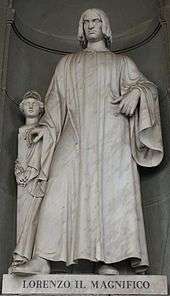Platonic Academy (Florence)
The Platonic Academy (also known as the Neoplatonic Florentine Academy)[1] was a 15th-century discussion group in Florence, Italy.
History

The Neoplatonic Florentine Academy was founded after Gemistus Pletho reintroduced Plato's thoughts to Western Europe during the 1438–39 Council of Florence. It was sponsored by Cosimo de' Medici, led by Marsilio Ficino and supported by Medici until death of Lorenzo de' Medici. It was never a formal group but the members considered themselves a modern form of Plato's Academy. Important members were Poliziano, Cristoforo Landino, Pico della Mirandola, and Gentile de' Becchi. The academy would proceed to translate into Latin all of Plato's works, the Enneads of Plotinus, and various other Neoplatonic works.[2]
Pico della Mirandola became the first Christian scholar to master the Jewish mystical theology of Kabbalah. He attempted to develop a form of syncretism whereby different systems of thought could be harmonized based on shared elements of truth. Pico asserted that even though Platonism and Christianity had different views, they held some truths in common. An important aspect of Pico's philosophical thought was his defense of the dignity and liberty of the human being, set forth in Oration on the Dignity of Man (1486). Both Ficino and Pico resurrected the humanistic views of ancient Greece. However, the humanism of the Renaissance was more individualistic than the humanism of ancient times.
The biographer John Addington Symonds speculates that Michelangelo Buonarroti spent time among the members of the Platonic Academy during Buonarroti's early years in Florence, fully absorbing its doctrines and later authoring poems and other works demonstrating agreement with their doctrines.[3]
The Academy was in fact dissolved soon after the death of Lorenzo de' Medici in 1492. Poliziano and Mirandola both died in 1494. In 2007, their bodies were exhumed from the Church of San Marco in Florence to establish the causes of their deaths.[4] Forensic tests showed that both Poliziano and Pico likely died of arsenic poisoning, possibly the order of Lorenzo's successor, Piero di Lorenzo de' Medici.[5]
References
- Peter Burke, The Renaissance, Longmans, 1964, p. 152.
- Hunt, Lynn; Martin, Thomas R.; Rosenwein, Barbara H.; Hsia, R. Po-chia; Smith, Bonnie G. (2007), The Making of the West, II (Second ed.), Boston: Bedford/St. Martin's, ISBN 978-0-312-43946-0
- The Life of Michelangelo, Symonds, J. A., Capricorn Books, 1962, pp. 405-408.
- Medici writers exhumed in Italy. BBC News, 28 February 2007. Accessed June 2013.
- Malcolm Moore (7 February 2008). "Medici philosopher's mysterious death is solved" The Daily Telegraph. London. Accessed June 2013.